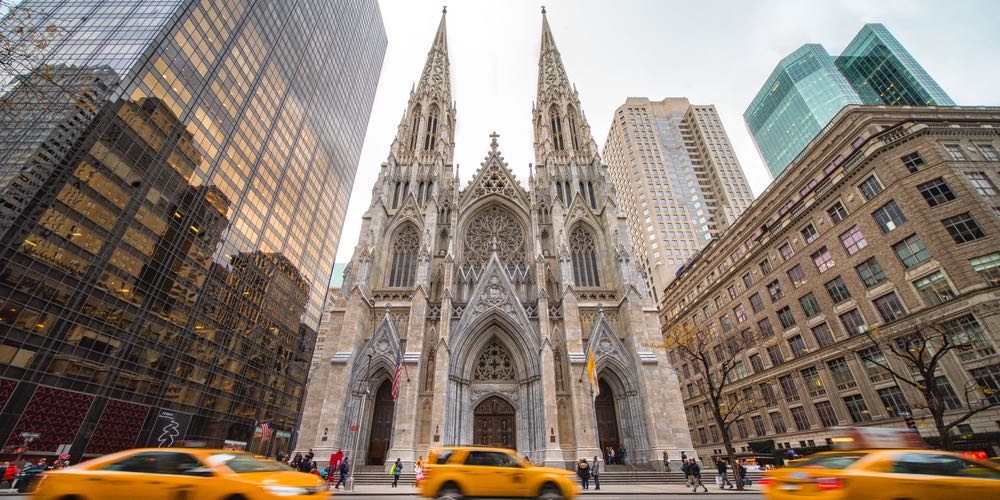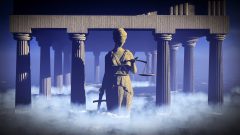Prayer in the City
During the climax of the 1984 film Ghostbusters, our heroes Egon Spengler, Peter Venkman, Ray Stantz, and Winston Zeddemore arrive outside the Manhattan apartment building where Zuul awaits them for a final confrontation. Upon exiting the Ecto-1, they find a large crowd of supporters cheering them on. A sizable portion of the crowd is religious. Rabbis, priests, pastors, and nuns pray and cheer as the Ghostbusters enter the building. After the Ghostbusters succeed in defeating Zuul, the religious figures share in the city-wide celebration. The movie is a celebration of New York City, and these religious figures help make up the cultural setting, giving the film its New York sensibility. We tend to overlook this today. By 1984, of course, the unique religious culture of New York was in decline, but many of the original audience likely remembered how the city used to be—and for some still was—a major religious center.
For contemporary readers, this view of New York might seem very strange. Most grew up after the difficult years of the 1970s and 1980s, when the city once again became the destination for the nation’s creative class. During the 1990s we grew accustomed to the religion-free world of Friends, Sex and the City, and Girls. Jon Butler’s God in Gotham: The Miracle of Religion in Modern Manhattan serves as a reminder of how vital religiosity was to the old New York of 1900-1960. During this period, Protestants, Catholics, and Jews confronted rapid technological and social change, creating a thriving religious culture. Their contributions are sewn into the cultural fabric of the city, still evident in pockets of religious institutions, and in now-abandoned or repurposed religious buildings.
The book opens with a discussion of the largely Protestant concern about the need to re-engage American culture as it transitioned from a slower-moving agricultural society to a fast-paced, industrial nation. As the nation’s population moved away from rural areas and into the cities, things changed rapidly, and no city had a greater influence on national culture than New York. Hence, Protestant leaders decided to embrace another major change borne of the industrial revolution: professional management techniques. Butler explains how demographer Samuel Loomis compiled findings ranging from British studies of urban religion to the successes of Archbishop John Ireland of St. Paul. He published his results in his 1887 Modern Cities and Their Religious Problems.
The book offers a myriad of solutions: shortening sermons, establishing “deaconesses” to support church efforts, and reinventing old-time religion for the new-fangled city life. Not to be outdone were religious entrepreneurs like rabbis in Jewish shuls who repurposed apartments for minyans to hold services, and Catholic clergy who rapidly established parochial schools for the children of immigrants from southern and central Europe. Some made do with less: Butler recounts how black ministers in Harlem rented old storefronts until they could raise funds from congregations to build their own churches.
During this period, many of New York’s greatest religious institutions flourished, such as Abyssinian Baptist Church, Riverside Church, Marble Collegiate Church, and St. Patrick’s Cathedral. It was in the New York of the early twentieth century where Jews began Conservative Judaism, and founded the Jewish Theological Seminary and Yeshiva University. Norman Vincent Peale, Henry Sloane Coffin, and Ven. Fulton J. Sheen gave sermons to packed crowds that spilled onto sidewalks.
What prompted this success was the embrace of the modernity that the early Protestant urban missionaries first feared. Churches and synagogues remained places of worship, but they became major social hubs with everything from women’s organizations to congregational gymnasiums. They also became major humanitarian centers during the Great Depression, offering political solidarity against anti-Semitism, anti-Catholicism, and eventually Jim Crow segregation. To these ends, religious leaders exploited the development of cheap paperback publishing to distribute congregational newsletters, catechisms, and newsletters. Local newspapers printed popular sermons in their pages, and soon, as Butler details, these clergy found their way onto radio and television, as well. It made sense, given New York’s early role as the broadcasting capital to America.
In the early chapters, Butler structures God in Gotham chronologically, with the Protestant concern over urbanization and the struggle of Jewish and Catholic immigrants to adjust to their new homes. However, the heart of the book transitions to denominational and racial discussions. There are chapters on white Protestant, Catholic, Jewish, and black Protestant developments. Butler does not tightly adhere to these divisions, however, since the lives of these congregations were intertwined. Anyone scanning this review for a sample quotation or vignette from the text will be disappointed; the book defies such an effort. Butler is a master of the craft, giving a deep historical account of the city by whisking the reader from figures as wide-ranging as Catholic Archbishop John McCloskey and Rabbi Solomon Schechter to Reverend Adam Clayton Powell, Jr., and his father. The book rewards slow reading of the sections on each church or religious leader, since their stories build on one another until the conclusion.
Butler’s ultimate conclusion might surprise many readers. He does not believe that the decline of religiosity in New York—and, by extension, in America—is a permanent trend. He ties the conclusion to the book’s introduction, reminding us that it is normal to go through periods in which religious leaders worry about decreasing religiosity and religious attendance. A little over a century ago, New York’s religious leaders were worried about rapid social change as well, and they found ways to build up new institutions that served city-dwellers’ spiritual needs. One prevailing view suggests that the suburban exodus of the 1950s and 1960s led to the decline of religiosity among those leaving. Butler disputes this. He observes how contemporary accounts of the suburban religiosity of the 1950s and 60s remain relatively continuous. The new suburbanites founded churches modeled on their older urban institutions, from publishing newsletters to providing community gathering spaces. Butler concludes:
Yet signs of twenty-first-century religious renewal seem equally present. As mainline denominations have sputtered, evangelical Protestant communities have grown in numbers and militance. Evangelical mega-churches appear not only in the suburbs but also in New York City and other urban places. Religion is of enormous importance in voting, whether among Orthodox Jews in New York or Protestant evangelicals across the nation…Those who fear for the future or religion would do well to keep in mind all the ways that Weber, James, Winter, Herberg, Graham, and so many others got it wrong. For all their rich insights and moving rhetoric, their sense that religion was not keeping up with surrounding society—that it was either collapsing or changing so completely as to become meaningless—was misplaced time and again.
Indeed, Butler strongly implies that one motivation for writing this book was to give hope to religious Americans today. The present disaffiliation among younger Americans is nothing new but, in his view, part of a cycle that emerges whenever America undergoes a rapid social change. Such changes have occurred regularly and, with them, religious organizations have adapted and flourished.
During a 2016 Republican Nomination Debate, Senator Ted Cruz of Texas condemned what he called “New York values,” which to his audience meant sexual libertinism, repression of religious life, and a contemptuous elite culture. Butler gives readers a deeper sense of how “New York values” were once a modus vivendi for religious pluralism that provided a broadly religious foundation for American culture. He believes that it could be so again.
Arguably, such a revival has already taken place. In New York City, the now-retired Reformed minister Tim Keller staged a significant revival among Reformed Protestant congregations that has produced a huge number of churches. Butler overlooks these recent events, perhaps because of his historical cast of mind; however, such an oversight does not harm the quality of Butler’s book but rather illustrates his point. New York remains a dynamic city for American religious life, and these are the kind of “New York values” I can get behind.



